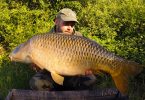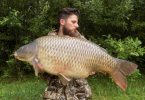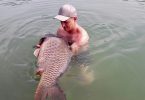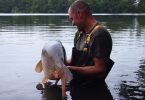Techniques to consider when targeting couta off fishing skis

Sun Rise off Inhaca Island
Its 5 am, just aft backline, you have your first batch of ‘livies’ in the live well securely tied to the ski. The African sun is beginning to creep over the horizon. The live bait on the end of our line is sending a pulse down your line, not dissimilar your own heart beat. There is no wind to speak of, yet. In an instant the tranquillity is shattered as a tormented couta comes boiling out of the depths, sending shafts of sunrise reflecting off its gleaming body. A savage strike, hammering heart, fish on! The “couta code†has been cracked….. for today that is!
The couta is the cause of many a fishing ski anglers’ elation, as well as being at the root of much disappointment, when they refuse to bite. By knowing your quarry and trying various techniques one can become more successful at targeting this species – Scomberomorous commersonm, the silver prince of the fishing ski community.
The couta prefers warmer waters and congregates in shoals off the Zululand and Mozambique coasts in winter, migrating south when the warm water moves off the Coast of Kwa Zulu Natal. The couta can reach a fork length of 200cm with a weight of 40kgs; these larger specimens tend to hunt singularly or in loosely formed shoals of only a few individuals.
Couta are hard fighting game fish, making many hard and fast runs before lending them selves to being boated. This fighting attitude, combined with the light tackle used by many ski anglers, makes landing couta from a ski a fantastic experience. A personal highlight whenever fighting couta is to look for shimmering silver flashes in the ink blue depths, as in the death of the fight couta often attempt to use the large surface areas of their flanks to resist coming to the boat. Another highlight of targeting couta is that when they are on the bite, there is not much time for anything else besides playing fish and baiting up.
On setting out to target couta, possibly the most important aspects to consider is water colour and water temperature. Ideal conditions are when the water is an ink blue colour and the water is warm, with a temperature of above 24oC. When the water is cold and a milky green colour the couta will become sluggish and averse to feeding. This being said even in perfect water the fish can cause much frustration by remaining “off†the bite. One can increase ones of chances of targeting couta successfully, rather dramatically, by fishing at the right times. Taking into account the crepuscular nature of couta, the old saying “the early bird catches the worm†has never been truer. Experience indicates clearly that the majority of couta being caught on Tourette Fishing Ski Safaris takes place during the hours of sunrise and sunset. The half an hour before sunset often resulting in larger, yet fewer fish.
The secret to consistently boating couta is to try different techniques until something is changed that entices the fish into taking the bait. Features to consider altering when tempting the fish to bite are: bait type and rigging, trolling speed, trolling depth, duster/skirt colour, and trace type.

Crocodile Couta at Pomene
Bait choice is varied and a very important consideration. Many anglers choose to fish with a particular bait such as mackerel, trip after trip. It is imperative to find what the fish are feeding on at your chosen destination and fish this bait as much as possible. On a recent fishing ski safari, fishing was disappointingly slow with only one couta being boated in the first two days. On gutting the fish it was discovered that the fish had gorged itself on small maasbankers. The following morning’s session began with fishing for live “mossiesâ€. That day, fishing with small live maasbankers, between the 4 clients, over 30 couta where landed, of which 24 where released.

Live baits will almost always produce better results than dead baits or artificial lures. Live baits are however a commodity not always available to the fishing ski angler. It is always recommended that, when fishing a new location, fishing ski anglers try and source some information concerning the whereabouts of likely spots to target live bait when out on the water. If, however, an area is fished frequently enough one will soon learn where the bait fish will congregate. Species that work well as live bait are: mackerel, maasbankers, shad and my personal favourite small bonito.
One of the most widely used methods to target couta is with dead baits. These can be rigged on a drift trace such as a duster or skirt trace, or a weighted bait swimmer trace. The bait should be rigged so the bait does not spin when pulled through the water. A spinning bait will significantly reduce strikes and result in a twisted line. Baits that are not weighted with bait-o-matics or bait swimmers can sometimes be difficult to stop spinning, particularly longer baits such has Wolf hearings and half beaks (preferred baits in Mozambique). The trebles must be adjusted until the spinning stops. A simple technique to stop these baits from spinning is to use a wood skewer pushed from the baits tail up into its head. This keeps the bait stiff and prevents a twisted line and a frustrated angler. Smaller baits such as red eyes are also prone to swim straighter. The dorsal fin of the bait can also be held up using a broken tooth pick. This acts as a small rudder and reduces the baits chances of spinning. When fishing with an un-weighted trace the best way to ensure the bait swims straight is slow down trawling speed, or simply drift.

If a fast trolling speed is being used it is best to rig the bait on a weighed trace, such as a trace with a bait swimmer. This enables the bait to be trawled at a higher velocity, without spinning – this will often produce better results by exciting the couta into an aggressive strike. On all fishing ski excursions, before each fishing session, clients are briefed on the route plan and preferred tactics for the morning/afternoon. What works well is to rig weighted baits and artificial lures (halco’s, feathers, coners etc) and paddle fast against the current or the direction of the prevailing wind (this often results in some fine live baits, such as bonito!) until the reef, pinnacle or drop off is reached. Fish the area until the wind picks up and then rigging un-weighted drift baits for the relaxed slow trip home.
Along with trolling speed, trolling depth should also always be considered. On most occasion’s one surface bait as well as a down rigged bait is used. A typical “fishing ski†down rigger consists of a teardrop sinker and a rubber band. The rubber band is looped onto the sinker and is used to attach the sinker to the main line. This sinker must be attached onto the line far in front of the bait, as this sinker can easily scare a skittish couta. Ten meters in front of the bait is generally safe. Depending on trolling speed and desired depth the sinker weight can be altered to change the trolling depth.
Duster and skirt colour must also be considered and are easily changed. Favourite colours that consistently produce fish are pink, chartreuse and pearl. It is however important to remember that on any one day the colour working can be something completely different.
Typical couta traces are normally tied on no.5 piano wire. The leading trace wire should be roughly the same length of the bait you will be using. Attached to this will be a tuna hook – size 3/0 or 4/0 depending on bait selection. For longer baits, half-beaks as an example, two trebles should be placed, one on each flank of the bait, the first midway down the bait and the second towards the tail. These trebles are attached to the eye of the leading hook with piano wire trace. Smaller baits, such as red eyes, require only one trailing treble hook. Once again all trebles should be arranged so as to ensure the bait swims straight. If fishing proves slow it is often a good idea to change to a thinner trace wire, or remove the leading trace wire and replace with fluorocarbon. A fluorocarbon leader of roughly 3 metres is used to attach traces to 20lb class nylon. The increased abrasion resistance that fluorocarbon offers is a great benefit when couta make long and hard runs potentially weakening/breaking conventional leader material with their slashing tail. Reels should hold at least 350 metres of 20lb line.
It is always good practice to fish in pairs, or threes when fishing off ski’s. Other than the obvious safety advantages, fishing in numbers allows a wider variety of tactics to be employed until the “couta code†is cracked.
By fishing any location over a prolonged time, one develops a fairly intimate knowledge of what will work, and what wont over a wide variation of conditions. This is a definite asset as potentially fruitful fishing time will not be used up with frustrating hit or miss tactics. Once again, there is no better tutor than time on the water. Go on, get out there, and get creative!
Rob Scott and Keith Clover – Tourette Fishing
www.tourettefishing.com








